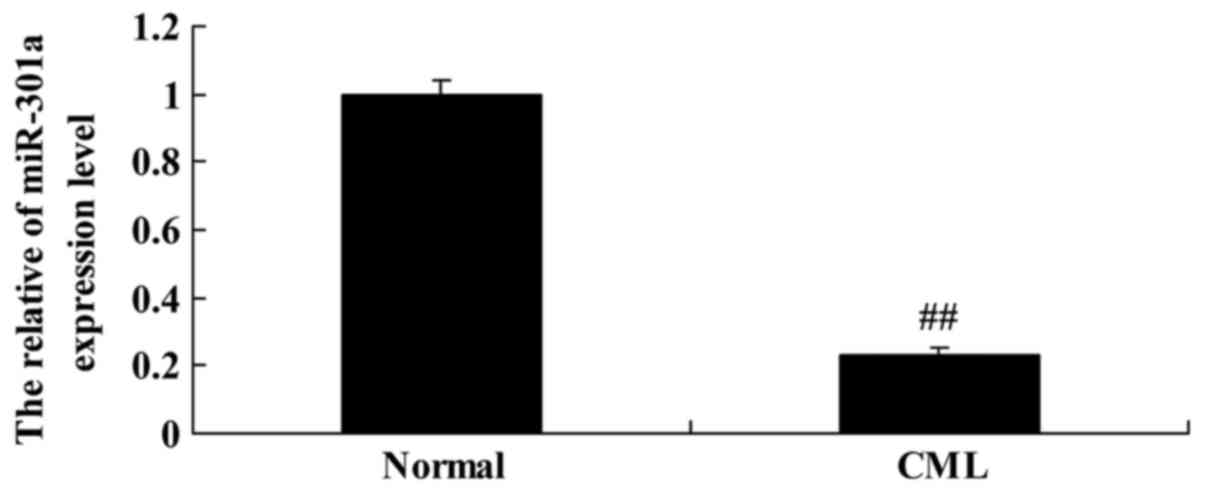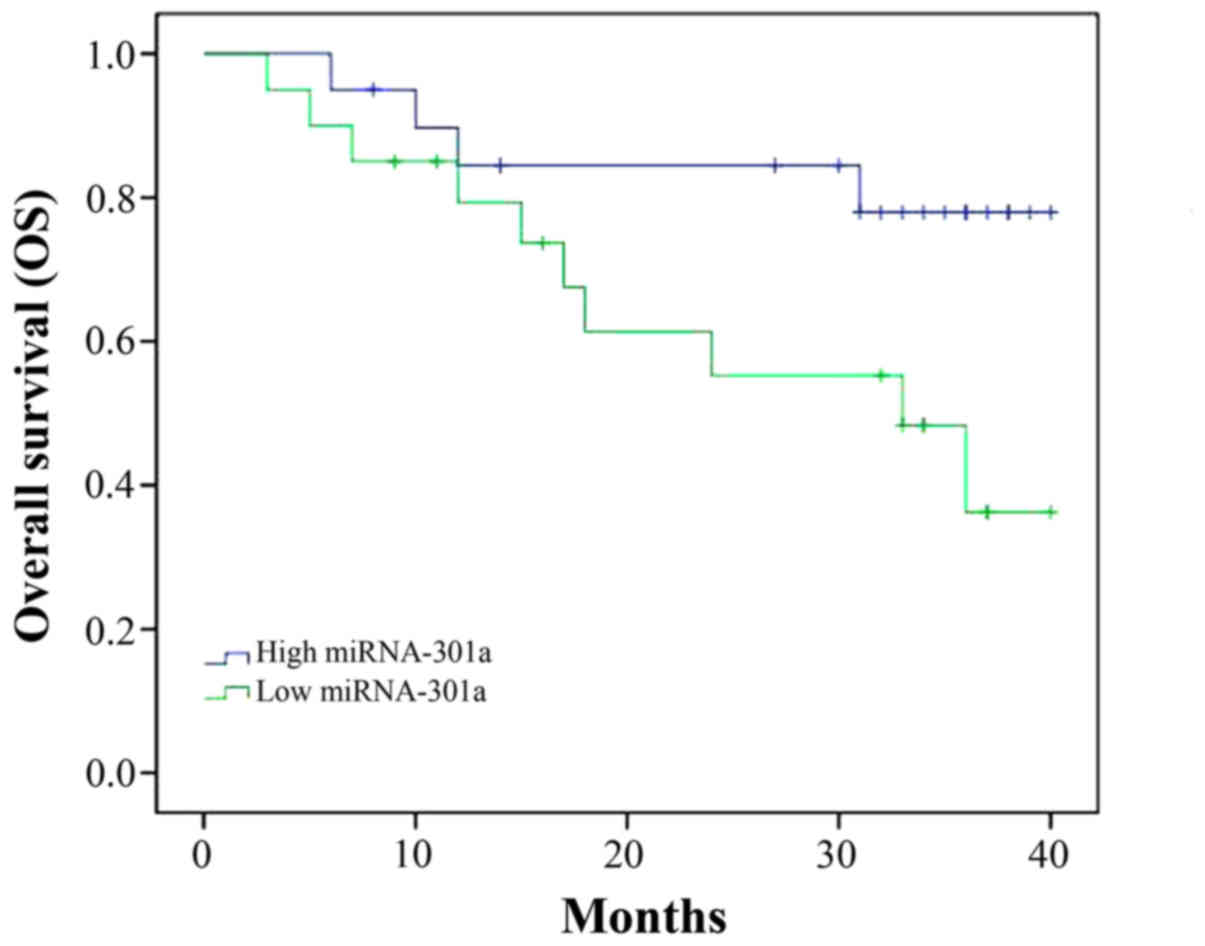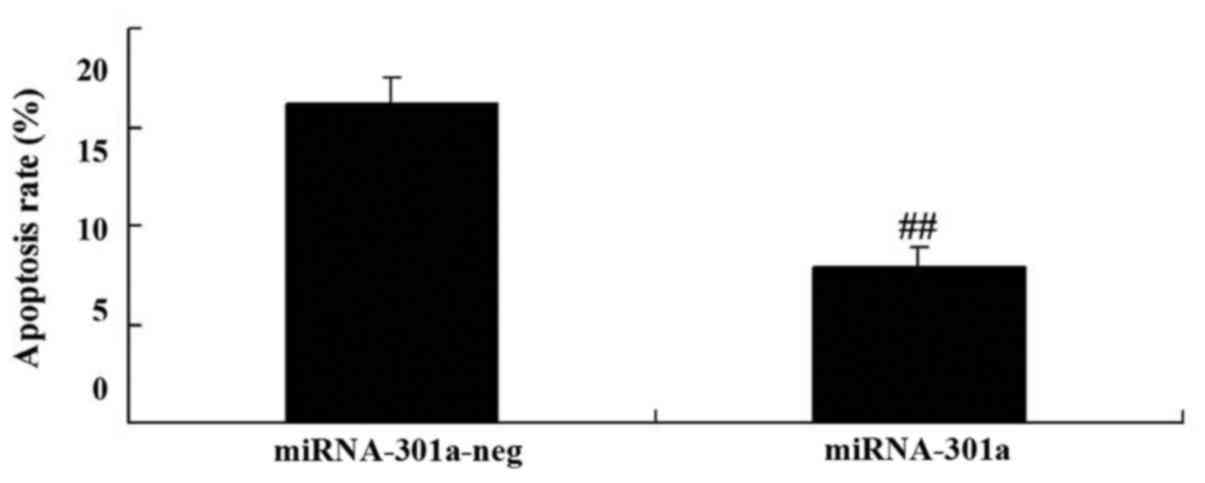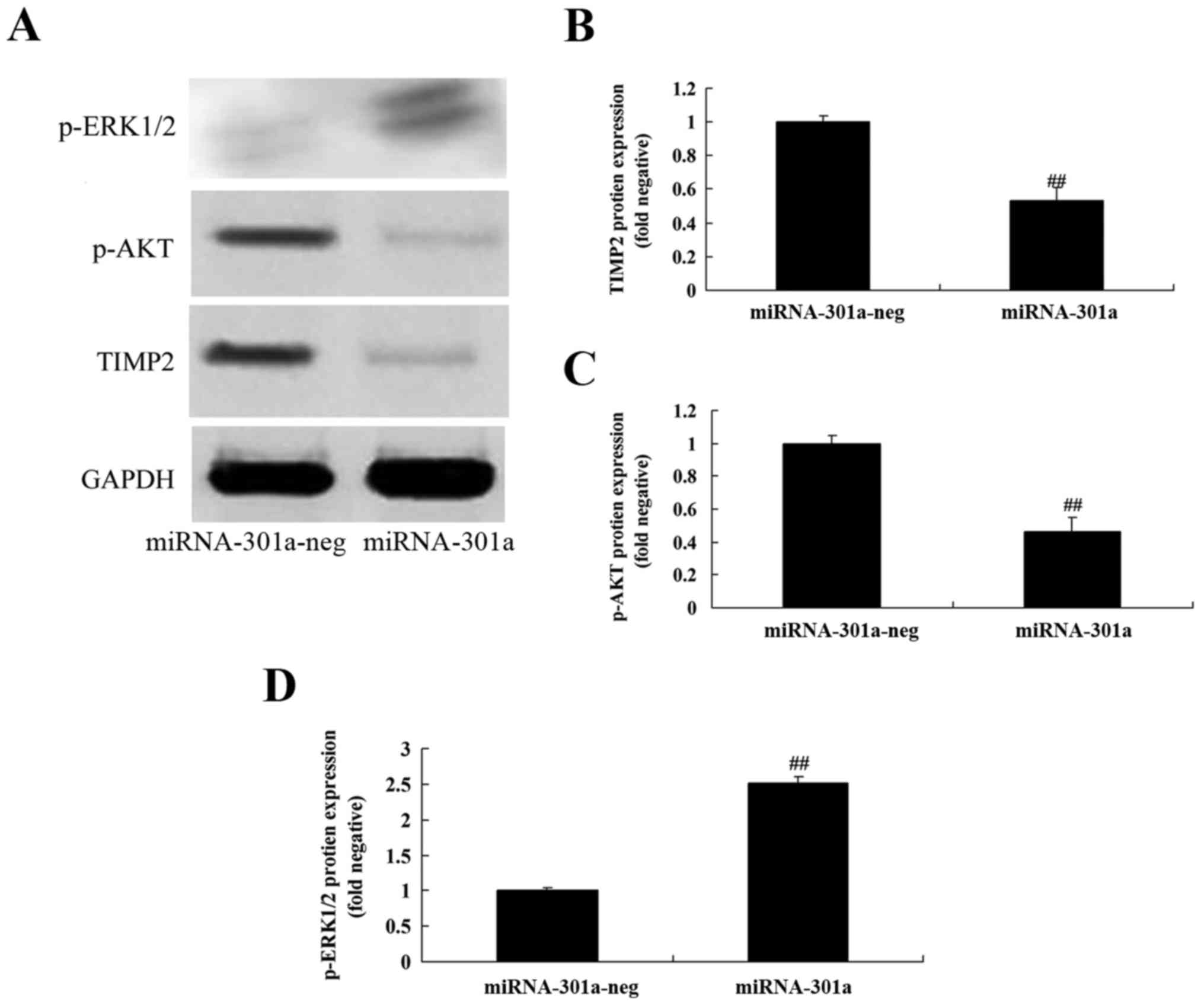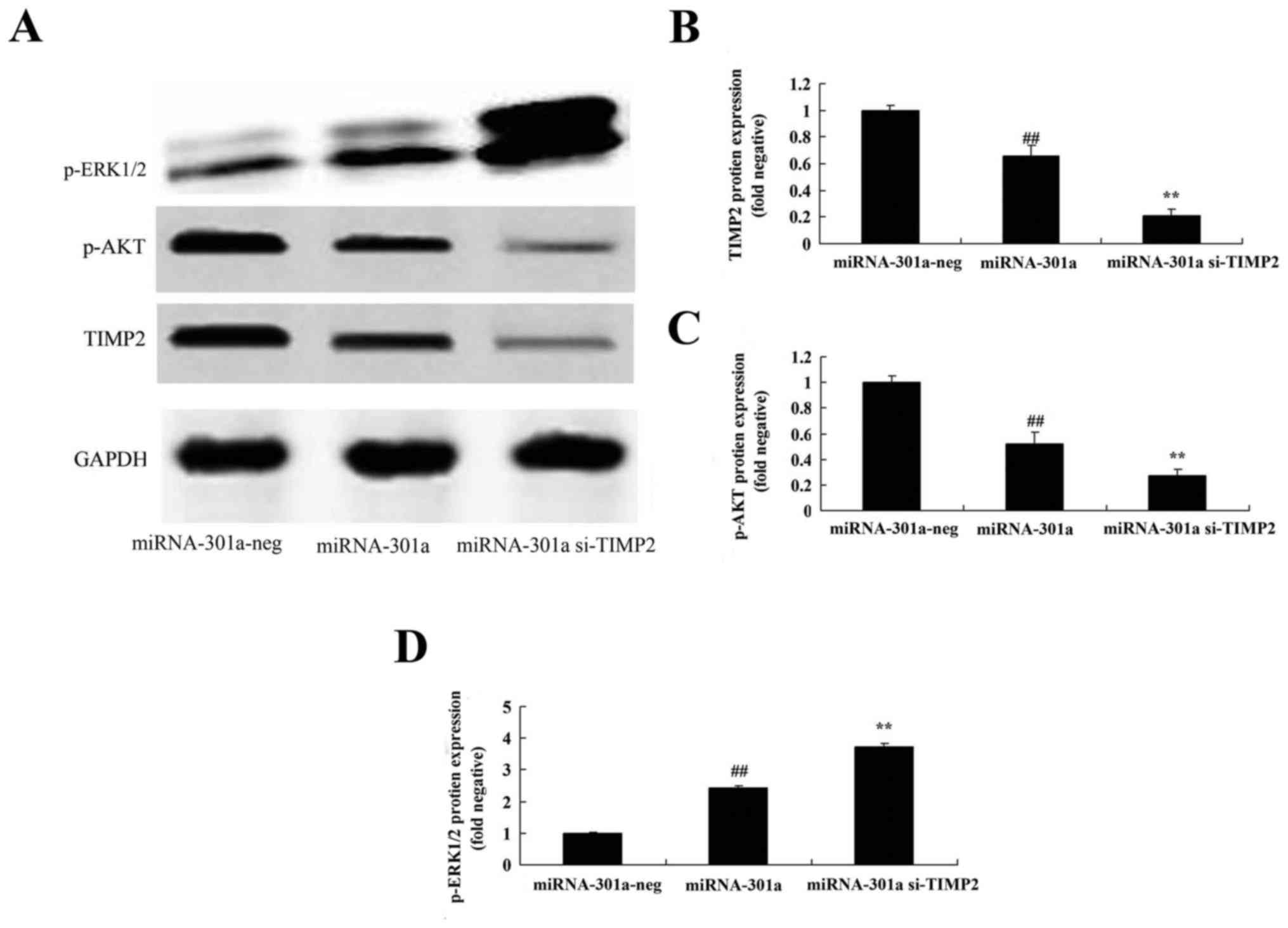miRNA-301a induces apoptosis of chronic myelogenous leukemia cells by directly targeting TIMP2/ERK1/2 and AKT pathways
- Authors:
- Published online on: December 22, 2016 https://doi.org/10.3892/or.2016.5330
- Pages: 945-952
Abstract
Introduction
Chronic myelogenous leukemia (CML) is one of the common types of chronic leukemia in China that occurs in all age groups (1). Though the traditional therapeutic drugs such as hydroxycarbamide and interferon can improve the symptoms in patients within a certain period, they can neither cure this disease, nor block the disease progression (2). An overwhelming majority of patients will enter the acceleration phase or the blastic phase after a period of chronic phase, and finally die of complications such as hematopoietic failure or infection. The fusion gene bcr/abl is the genetic and molecular biological feature of CML, and its product Bcr/Abl kinase is the key factor of pathogenesis. Since Bcr/Abl kinase possesses strong tyrosine kinase activity, the tyrosine kinase inhibitors (TKIs) such as imatinib serve as the first-line therapeutic drugs for leukemia applied in clinic (3). It is found during treatment that imatinib shows excellent therapeutic effect on the chronic phase of CML; however, resistance occurs in some patients. As demonstrated in research, Bcr/Abl kinase can activate multiple intracellular signaling pathways, for instance, Ras/MAPK, Jun/STAT5 and PI3K/Akt/mTOR, and thus influence the cell cycle distribution and cell apoptosis, leading to the genesis of CML.
MicroRNA (miRNA) is a type of single stranded non-coding microRNA that is ~20 nt in length, and it mainly exerts its posttranscriptional regulatory function through degrading its target gene or inhibiting its translation by complete or incomplete pairing with the target gene 3′-UTR (4). In-depth research on the mechanisms of the production and precise action of miRNA demonstrated that miRNA plays significant roles in the development regulation, differentiation, proliferation, cell apoptosis and metabolism (5). The disordered expression of miRNA may participate in the genesis and development of a tumor, including some hematological tumors. Because miRNA can directly regulate the expression of some oncogenes or tumor suppressor genes after transcription, it can exert functions that are similar to tumor suppressor genes or oncogenes in the body; for instance, miR-424 can induce apoptosis by targeting oncogene BCL-2; while miR-21 negatively regulates the expression of the tumor suppressor gene PTEN and promotes cell proliferation and invasion (5,6).
Matrix metalloproteinase-2 and −9 (MMP-2 and MMP-9) have the important function of hydrolyzing gelatin, type I, IV, V, VII and X collagens as well as elastin (7). Their corresponding tissue inhibitors of metalloproteinase (TIMP) are TIMP-2 and TIMP-1, respectively (8). It has been reported that many solid tumors, such as human breast cancer, endometrial cancer, brain tumor, colorectal cancer and pancreatic cancer, are associated with high gelatinase expression (9). A recent study indicated that TIMP-2 is closely related to the genesis and development of hematological tumor diseases, such as leukemia and myelodysplastic syndrome (10).
The common biological feature of a tumor is the uncontrolled growth, the major molecular mechanism of which is the inhibited cell malignant proliferation and apoptosis (11). The multiple pathological mechanisms that are involved in the transformation, proliferation and apoptosis of malignant tumors are correlated with the regulation of signaling pathways, among which, RaS/Raf/ERK signal transduction cascade pathway is one of the important pathways. The extracellular signal-regulated kinase (ERK) is a subgroup of the mitogen actived protein kinase (MAPK) family, which can be divided into ERKl and ERK2 and is generally termed as ERKl/2 (11). ERKl/2 takes part in cell proliferation, differentiation, transformation and apoptosis after being activated by numerous growth factors and cytokines. Recent research suggests that the excessively activated ERKl/2 is related to the genesis of the tumor (11). ERK is associated with the abnormal expression or enhanced activity in multiple tumor tissues as well as tumor cell lines, such as liver cancer, breast cancer, oral squamous cell carcinoma and prostate cancer (12).
Tumor is a common malignancy, however, the pathogenesis is still unclear (13). With the increasing in-depth research on tumors, more and more signaling pathways that play important regulatory effects on the growth and development of organism are proved to be correlated with tumors, among which there are PI3K/Akt signaling pathway, JAK/STAT signaling pathway, MAPK signaling pathway and Wnt/Notch signaling pathway (14). PI3K/Akt signaling pathway is the most extensively studied, it plays an important role in the development of leukemia (15). Numerous studies have demonstrated that EpsS, which participates in EGFR signaling pathway, Rac signaling pathway, PI3K/Akt signaling pathway and mitosis signaling pathway, also plays an important role in the cell cycle and apoptosis (16). The purpose of this study was to investigate the cancer mediation effect of miRNA-301a on apoptosis of CML and its possible mechanism.
Materials and methods
Ethics statement
Bone marrow and peripheral blood samples were evaluated from 42 CML patients and 8 normal volunteer at Department of Hematology, The First Affiliated Hospital of Nanchang University from 2012, September to 2012, December. All patients and volunteer were obtained from the clinical trials and biomedical ethics special committee of The First Affiliated Hospital of Nanchang University. Every two months, we made a followed-up of the patients.
Quantitative real-time PCR
Total RNA was extracted from CML patients or normal volunteer samples or cell lines using TRIzol reagent (Invitrogen, Carlsbad, CA, USA). Total RNA (1 µg) was synthesized into complementary DNA (cDNA) using reverse transcriptase (Epicentre, Madison, WI, USA). A SYBR Green PCR kit (Takara, Dalian, China) was used in quantitative real-time PCR. The primers for miR-301a were: forward, 5′-GGCAGTGCAATAGTATTGT-3′ and reverse, 5′-TGGTGTCGTGGAGTCG-3′. The relative miR-301a expression level was determined by using the 2−ΔΔCT method.
Cells and reagents
The K562 cells were cultured in RPMI-1640 (Hyclone, Logan, UT, USA) supplemented with 10% fetal bovine serum (Gibco, Grand Island, NY, USA) in an incubator maintained at 37°C in an atmosphere containing 5% CO2.
Plasmids transfection
miRNA-301a, si-TIMP2 and negative plasmids were purchased from Genechem (Shanghai, China). K562 cells were transfected using Lipofectamine 2000 transfection reagent (Invitrogen).
Cytotoxicity assay
The K562 cells were seeded in 96-well plates at 1×105 cells per well, and 20 µl 3-(4, 5-dimethylthiazol-2-yl)-2, 5-diphenyltetrazolium bromide (MTT) solution (5 mg/ml) was added to each well and incubated at 37°C for 4 h. After removing the medium, 100 µl of DMSO (Sigma) was added to solubilize the crystals and the absorbance was measured using scanning multiwell spectrophotometer (Model 550, Bio-Rad, Hercules, CA, USA) at 450 nm.
Flow cytometric analysis
The K562 cells were seeded in 6-well plates at 2×106 cells per well and washed twice with phosphate-buffered saline (PBS). K562 cells were incubated with Annexin V-FITC and PI (BD Biosciences) for 15 min in the dark. Apoptosis rate was analyzed using FACScan flow cytometry and CellQuest analysis software (BD Biosciences, Franklin Lakes, NJ, USA).
Western blotting
The K562 cells were seeded in 6-well plates at 2×106 cells per well and washed twice with PBS. Cells were lysed using RIPA buffer containing a protease and phosphatase inhibitor mixture (Roche). Total protein was quantified with the BioRad Dc protein assay kit (Bio-Rad, Richmond, CA, USA). Protein was loaded onto 6–10% sodium and electro-transferred to polyvinylidene difluoride membranes (Millipore, Billerica, MA, USA). Membranes were incubated with the primary antibody anti-Bax, anti-Bcl-2, anti-TIMP2, anti-phosphorylation-ERK1/2, anti-phosphorylation-AKT and GAPDH overnight at 4°C, followed by incubation with the anti-rabbit secondary antibody for 1 h at room temperature. Bands were detected by enhanced chemiluminescence (ECL) detection system (Bio-Rad Laboratories).
Statistical analysis
The results are reported as means ± standard deviation (SD). Student's t-test, one-way analysis of variance (ANOVA) and the Dunnett-test were used to assess statistical significance. Values of p<0.05 were considered statistically significant.
Results
The expression of miRNA-301a in patient with CML
To explore the expression level of miR-301a in CML patients, we performed quantitative real-time PCR on miRNA-301a expression. Interestingly, we found that miR-301a expression level of CML patients were lower than that of the normal group (Fig. 1).
Overall survival (OS) of patient with CML
We followed up the patient with CML and analyzed the OS of patient with CML and miRNA-301a expression. As shown in Fig. 2, OS of CML patient with high miRNA-301a expression was superior to that of CML patient with low miRNA-301a expression.
Upregulation of miRNA-301a affects cell proliferation of K562 cells
The upregulation of miRNA-301a on cell proliferation of K562 cells was investigated using MTT assay. Fig. 3A shows that miRNA-301a plasmids significantly increased miRNA-301a expression in K562 cells, compared with the negative control group. Then, we found that miRNA-301a upregulation significantly accelerated cell proliferation of K562 cells, compared with the negative control group (Fig. 3B).
Upregulation of miRNA-301a affects apoptosis of K562 cells
To evaluate whether the upregulation of miRNA-301a affect apoptosis of K562 cells, apoptosis was investigated using western blotting. Apoptosis of K562 cells was reduced by upregulation of miRNA-301a expression, compared with negative control group (Fig. 4).
Upregulation of miRNA-301a affects caspase-3 and −9 activity of K562 cells
The effect of miRNA-301a upregulation on caspase-3 and −9 activity of K562 cells, was measured using ELISA kits. As shown in Fig. 5, upregulation of miRNA-301a significantly decreased caspase-3 and −9 activity of K562 cells, compared with negative control group.
Upregulation of miRNA-301a affects Bax/Bcl-2 rate of K562 cells
We observed the upregulation of miRNA-301a on Bax/Bcl-2 rate of K562 cells. We found that the upregulation of miRNA-301a significantly suppressed Bax/Bcl-2 rate of K562 cells, compared with negative control group (Fig. 6).
Upregulation of miRNA-301a affects TIMP2 protein expression of K562 cells
To evaluate whether the upregulation of miRNA-301a affects TIMP2 protein expression of K562 cells, western blotting was performed to examine the level of TIMP2 protein of K562 cells with upregulation of miRNA-301a. TIMP2 protein expression of K562 cells was significantly decreased by upregulation of miRNA-301a, compared with negative control group (Fig. 7A and B).
Upregulation of miRNA-301a affect on Akt protein expression of K562 cells
Akt is an anti-apoptotic protein, we inspected p-Akt protein expression of K562 cells after miRNA-301a transfection. As shown in Fig. 7A and C, upregulation of miRNA-301a significantly suppressed p-Akt protein expression of K562 cells, compared with negative control group.
Upregulation of miRNA-301a on ERK protein expression of K562 cells
We elucidated whether the upregulation of miRNA-301a affects the mechanism apoptosis of K562 cells, p-ERK protein expression was detected using western blotting. The results of western blotting showed that upregulation of miRNA-301a significantly advanced p-ERK protein expression of K562 cells, compared with negative control group (Fig. 7A and D).
Downregulation of TIMP2 expression influences the effect of miRNA-301a on TIMP2 protein expression of K562 cells
We explored the TIMP2 expression of miRNA-301a on cell growth of CML, and transfected si-TIMP2 into K562 cells. As shown in Fig. 8A and B, si-TIMP2 effectively suppressed the TIMP2 protein expression of K562 cells, compared with upregulation of miRNA-301a expression in K562 cells.
Downregulation of TIMP2 expression influences the effect of miRNA-301a on cell proliferation and cell apoptosis of K562 cells
We further examined downregulation of TIMP2 expression of miRNA-301a on cell proliferation and cell apoptosis of K562 cells. We found that the downregulation of TIMP2 expression effectively increased cell proliferation and inhibited cell apoptosis of K562 cell transfection with upregulation of miRNA-301a, compared with upregulation of miRNA-301a expression in K562 cells (Fig. 9).
Downregulation of TIMP2 expression influences the effect of miRNA-301a on caspase-3 and −9 activity of K562 cells
We transfected K562 cells with si-TIMP2 and determine caspase-3 and −9 activity of K562 cells with upregulation of miRNA-301a. Results from ELISA assay showed that downregulation of TIMP2 expression inhibited caspase-3 and −9 activity of K562 cells with upregulation of miRNA-301a, compared with upregulation of miRNA-301a expression in K562 cells (Fig. 10).
Downregulation of TIMP2 expression influences the effect of miRNA-301a on Bax/Bcl-2 rate of K562 cells
To determine whether TIMP2 would affect K562 cell apoptosis with upregulation of miRNA-301a, Western blotting was performed to analyze the protein expression of Bax and Bcl-2 as shown in Fig. 11. The protein expression of Bax/Bcl-2 rate was significantly decreased by downregulation of TIMP2 in K562 cells with upregulation of miRNA-301a, compared with upregulation of miRNA-301a expression in K562 cells.
Downregulation of TIMP2 expression influences the effect of miRNA-301a on Akt protein expression of K562 cells
The TIMP2-mediated signaling was examined to elucidate the Akt activation of K562 cells with upregulation of miRNA-301a. After miRNA-301a transfection, the downregulation of TIMP2 expression significantly suppressed p-Akt protein expression of K562 cells with upregulation of miRNA-301a, compared with upregulation of miRNA-301a expression in K562 cells (Fig. 8A and C).
Downregulation of TIMP2 expression influences the effect of miRNA-301a on ERK protein expression of K562 cells
We further elucidate whether downregulation of TIMP2 expression influenced the effect of miRNA-301a on ERK protein expression of K562 cells. As shown in Fig. 8A and D, after miRNA-301a transfection, the downregulation of TIMP2 expression significantly enhanced p-ERK protein expression of K562 cells with upregulation of miRNA-301a, compared with upregulation of miRNA-301a expression in K562 cells.
Discussion
CML is a common hematological malignant tumor, the morbidity of which accounts for ~20% among all types of leukemia, with an annual rate of 10/1,000,000 people affected worldwide (17). Ph chromosome can be detected in CML patients, and the resulting bcr-abl fusion gene encoded P210 Bcr-Abl protein possesses strong tyrosine kinase activity, which results in the phosphorylation of the protein itself, as well as many important substrate molecule tyrosine residues, influencing multiple intracellular signal transduction pathways such as Ras/MAPK, PI3K/Akt and JAK/STAT, inducing the malignant transformation of the hematopoietic cells, enhancing the ability of cells to repair DNA injury, inhibiting apoptosis, and mediating resistance of CML to multiple cytotoxic antitumor drugs (18,19). We concluded that miR-301a expression level of CML patients were lower than that of normal group. Yue et al revealed that miR-301a promoted invasion of glioma cells through Wnt/β-catenin pathway (20).
The genesis and development of leukemia is an extremely complicated process, which involves genetic and epigenetic changes (4). Upregulated or downregulated expression of miRNA can be detected in various leukemia types, such as CML, chronic lymphocytic leukemia, CML and acute myeloid leukemia (AML) (21). In CML, the changes in miRNA expression render changes of the living environment of the tumor cells, thus accelerating malignant transformation such as tumor cell proliferation, apoptosis escaping, angiogenesis and invasion (21,22). Our results demonstrated that the upregulation of miRNA-301a increased cell proliferation, inhibited apoptosis, caspase-3 and −9 activity, and suppressed Bax/Bcl-2 rate of K562 cells.
MMP-2 exists in the form of zymogen, and the ternary theory is widely accepted at present in terms of its activation, which means that the MMP-14 on the cell membrane binds with TIMP-2 to form the compound, and then TIMP-2 will bind with MMP-2 to form the ternary compound, which renders the easier junction between MMP-2 and another adjacent active MMP-14 in space; moreover, MMP-2 is also activated, thus forming the active form (2). The results demonstrate that there is no expression of MMP-2 and MMP-14 in the normal adult bone marrow mononuclear cells, but someexpression of TIMP-2; all the bone marrow mononuclear cells in CML patients express TIMP-2, and 90% express MMP-2 and MMP-14 (23). Considering that the chronic phase in CML patients is under the self-balanced status relative to the acute leukemia, while TIMP-2 may be an influencing factor for inhibiting disease progression, the loss of balance may result in the disability to inhibit MMP-2, the excessive expression leads to disease progression (24). Here, we showed that upregulation of miRNA-301a significantly decreased TIMP2 protein expression of K562 cells. Liang et al reported that miR-301a promotes cell proliferation by directly targeting TIMP2 in multiple myeloma (25). These findings suggest that miRNA-301a may function as a novel oncogene in CML contributing to tumor progression of CML.
P210Bcr-Abl fusion protein induces the phosphorylation of the tyrosine in multiple intracellular signaling molecules through its high tyrosine kinase activity, thus activating multiple signaling pathways such as Ras/MAPK, PI3K/Akt and JAK/STAT, the activation of these signaling molecules is the molecular basis of the anti-apoptosis of Bcr-Abl (26). The signaling pathway activation downstream of Bcr-Abl also participates in the formation of the resistance to imatinib. CRKL protein is the adaptor protein during the intracellular signal transduction process, which participates in signal transduction pathways like Ras/MAPK JAK/STAT PI3K as well as β1 integrin-mediated signal transduction pathway (27). CRKL gene is abundantly expressed in hematopoietic cells, while in normal hematopoietic cells, CRKL protein exists in the form of non-phosphorylated tyrosine. PI3K/Akt and MAPK/ERK are the two important pathways downstream of Bcr/Abl (28). The chronic phase and blastic phase of CML as well as the CML-derived K562 cell lines are associated with the constitutive activation of the ERK and Akt kinase (29). The application of imatinib in K562 cells can inhibit the activity of the ERK and Akt kinase, and induce cell apoptosis through activating caspase-3. However, in some primary leukemia cells in the CML blastic phase, inhibiting the activity of the ERK and Akt kinase can induce caspase-3 mediated apoptosis, giving rise to the occurrence of resistance (30). In this study, we observed that upregulation of miRNA-301a significantly increased phosphorylation-ERK1/2 and decreased phosphorylation-AKT protein expression of K562 cell. These results indicate that ERK1/2 and AKT pathways affected miRNA-301a in CML.
Taken together, we demonstrated for the first time that miRNA-301a is significantly upregulated in CML. Moreover, miRNA-301a promotes cell proliferation and inhibits apoptosis of CML by direct targeting TIMP2. These results suggest that miRNA-301a may play as an oncogene in CML and might provide helpful therapeutic strategies for CML in clinical application.
References
|
Zhou L, Shi H, Jiang S, Ruan C and Liu H: Deep molecular response by IFN-α and dasatinib combination in a patient with T315I-mutated chronic myeloid leukemia. Pharmacogenomics. 17:1159–1163. 2016. View Article : Google Scholar : PubMed/NCBI | |
|
Chaudhary AK, Chaudhary S, Ghosh K, Shanmukaiah C and Nadkarni AH: Secretion and expression of matrix metalloproteinase-2 and 9 from bone marrow mononuclear cells in myelodysplastic syndrome and acute myeloid leukemia. Asian Pac J Cancer Prev. 17:1519–1529. 2016. View Article : Google Scholar : PubMed/NCBI | |
|
Janowska-Wieczorek A, Majka M, Marquez-Curtis L, Wertheim JA, Turner AR and Ratajczak MZ: Bcr-abl-positive cells secrete angiogenic factors including matrix metalloproteinases and stimulate angiogenesis in vivo in Matrigel implants. Leukemia. 16:1160–1166. 2002. View Article : Google Scholar : PubMed/NCBI | |
|
Di Stefano C, Mirone G, Perna S and Marfe G: The roles of microRNAs in the pathogenesis and drug resistance of chronic myelogenous leukemia (Review). Oncol Rep. 35:614–624. 2016.PubMed/NCBI | |
|
Hershkovitz-Rokah O, Modai S, Pasmanik-Chor M, Toren A, Shomron N, Raanani P, Shpilberg O and Granot G: Restoration of miR-424 suppresses BCR-ABL activity and sensitizes CML cells to imatinib treatment. Cancer Lett. 360:245–256. 2015. View Article : Google Scholar : PubMed/NCBI | |
|
Wang WZ, Pu QH, Lin XH, Liu MY, Wu LR, Wu QQ, Chen YH, Liao FF, Zhu JY and Jin XB: Silencing of miR-21 sensitizes CML CD34+ stem/progenitor cells to imatinib-induced apoptosis by blocking PI3K/AKT pathway. Leuk Res. 39:1117–1124. 2015. View Article : Google Scholar : PubMed/NCBI | |
|
Kreisel SH, Stroick M, Griebe M, Alonso A, Reuter B, Hennerici MG and Fatar M: True effects or bias? MMP-2 and MMP-9 serum concentrations after acute stroke. Cerebrovasc Dis. 42:352–360. 2016. View Article : Google Scholar : PubMed/NCBI | |
|
Wu YJ, Neoh CA, Tsao CY, Su JH and Li HH: Sinulariolide suppresses human hepatocellular carcinoma cell migration and invasion by inhibiting matrix metalloproteinase-2/−9 through MAPKs and PI3K/Akt signaling pathways. Int J Mol Sci. 16:16469–16482. 2015. View Article : Google Scholar : PubMed/NCBI | |
|
Ries C, Loher F, Zang C, Ismair MG and Petrides PE: Matrix metalloproteinase production by bone marrow mononuclear cells from normal individuals and patients with acute and chronic myeloid leukemia or myelodysplastic syndromes. Clin Cancer Res. 5:1115–1124. 1999.PubMed/NCBI | |
|
Golubnitschaja O, Yeghiazaryan K, Stricker H, Trog D, Schild HH and Berliner L: Patients with hepatic breast cancer metastases demonstrate highly specific profiles of matrix metalloproteinases MMP-2 and MMP-9 after SIRT treatment as compared to other primary and secondary liver tumours. BMC Cancer. 16:3572016. View Article : Google Scholar : PubMed/NCBI | |
|
Chen CC, Liu TY, Huang SP, Ho CT and Huang TC: Differentiation and apoptosis induction by lovastatin and γ-tocotrienol in HL-60 cells via Ras/ERK/NF-κB and Ras/Akt/NF-κB signaling dependent down-regulation of glyoxalase 1 and HMG-CoA reductase. Cell Signal. 27:2182–2190. 2015. View Article : Google Scholar : PubMed/NCBI | |
|
Liu J, Wang Y, Liu RH and He X: Novel triterpenoids isolated from raisins exert potent antiproliferative activities by targeting mitochondrial and Ras/Raf/ERK signaling in human breast cancer cells. Food Funct. 7:3244–3251. 2016. View Article : Google Scholar : PubMed/NCBI | |
|
Chien CM, Lin KL, Su JC, Chuang PW, Tseng CH, Chen YL, Chang LS and Lin SR: Naphtho[1,2-b]furan-4,5-dione induces apoptosis of oral squamous cell carcinoma: Involvement of EGF receptor/PI3K/Akt signaling pathway. Eur J Pharmacol. 636:52–58. 2010. View Article : Google Scholar : PubMed/NCBI | |
|
Li Q, Huai L, Zhang C, Wang C, Jia Y, Chen Y, Yu P, Wang H, Rao Q, Wang M, et al: Icaritin induces AML cell apoptosis via the MAPK/ERK and PI3K/AKT signaling pathways. Int J Hematol. 97:617–623. 2013. View Article : Google Scholar : PubMed/NCBI | |
|
Zeng D, Wang J, Kong P, Chang C and Li J and Li J: Ginsenoside Rg3 inhibits HIF-1α and VEGF expression in patient with acute leukemia via inhibiting the activation of PI3K/Akt and ERK1/2 pathways. Int J Clin Exp Pathol. 7:2172–2178. 2014.PubMed/NCBI | |
|
Yi YW, Hong W, Kang HJ, Kim HJ, Zhao W, Wang A, Seong YS and Bae I: Inhibition of the PI3K/AKT pathway potentiates cytotoxicity of EGFR kinase inhibitors in triple-negative breast cancer cells. J Cell Mol Med. 17:648–656. 2013. View Article : Google Scholar : PubMed/NCBI | |
|
Becker H, Suciu S, Rüter BH, Platzbecker U, Giagounidis A, Selleslag D, Labar B, Germing U, Salih HR, Muus P, et al: Decitabine versus best supportive care in older patients with refractory anemia with excess blasts in transformation (RAEBt) - results of a subgroup analysis of the randomized phase III study 06011 of the EORTC Leukemia Cooperative Group and German MDS Study Group (GMDSSG). Ann Hematol. 94:2003–2013. 2015. View Article : Google Scholar : PubMed/NCBI | |
|
Sakurai M, Mori T, Karigane D, Tozawa K, Matsuki E, Shimizu T, Yokoyama K, Nakajima H, Kanda Y and Okamoto S: Unfavorable outcome of chronic myelogenous leukemia in adolescent and young adults treated with tyrosine kinase inhibitors. Int J Hematol. 102:342–348. 2015. View Article : Google Scholar : PubMed/NCBI | |
|
Iriyama N, Fujisawa S, Yoshida C, Wakita H, Chiba S, Okamoto S, Kawakami K, Takezako N, Kumagai T, Inokuchi K, et al: Shorter halving time of BCR-ABL1 transcripts is a novel predictor for achievement of molecular responses in newly diagnosed chronic-phase chronic myeloid leukemia treated with dasatinib: Results of the D-first study of Kanto CML study group. Am J Hematol. 90:282–287. 2015. View Article : Google Scholar : PubMed/NCBI | |
|
Yue X, Cao D, Lan F, Pan Q, Xia T and Yu H: MiR-301a is activated by the Wnt/β-catenin pathway and promotes glioma cell invasion by suppressing SEPT7. Neuro-oncol. 18:1288–1296. 2016. View Article : Google Scholar : PubMed/NCBI | |
|
Bhutra S, Lenkala D, LaCroix B, Ye M and Huang RS: Identifying and validating a combined mRNA and microRNA signature in response to imatinib treatment in a chronic myeloid leukemia cell line. PLoS One. 9:e1150032014. View Article : Google Scholar : PubMed/NCBI | |
|
Valleron W, Laprevotte E, Gautier EF, Quelen C, Demur C, Delabesse E, Agirre X, Prósper F, Kiss T and Brousset P: Specific small nucleolar RNA expression profiles in acute leukemia. Leukemia. 26:2052–2060. 2012. View Article : Google Scholar : PubMed/NCBI | |
|
Song JH, Kim SH, Cho D, Lee IK, Kim HJ and Kim TS: Enhanced invasiveness of drug-resistant acute myeloid leukemia cells through increased expression of matrix metalloproteinase-2. Int J Cancer. 125:1074–1081. 2009. View Article : Google Scholar : PubMed/NCBI | |
|
Aref S, Osman E, Mansy S, Omer N, Azmy E, Goda T and El-Sherbiny M: Prognostic relevance of circulating matrix metalloproteinase-2 in acute myeloid leukaemia patients. Hematol Oncol. 25:121–126. 2007. View Article : Google Scholar : PubMed/NCBI | |
|
Liang B, Yin JJ and Zhan XR: MiR-301a promotes cell proliferation by directly targeting TIMP2 in multiple myeloma. Int J Clin Exp Pathol. 8:9168–9174. 2015.PubMed/NCBI | |
|
Wang H, Jia XH, Chen JR, Wang JY and Li YJ: Osthole shows the potential to overcome P-glycoprotein-mediated multidrug resistance in human myelogenous leukemia K562/ADM cells by inhibiting the PI3K/Akt signaling pathway. Oncol Rep. 35:3659–3668. 2016.PubMed/NCBI | |
|
Zhang X, Dong W, Zhou H, Li H, Wang N, Miao X and Jia L: α-2,8-sialyltransferase is involved in the development of multidrug resistance via PI3K/Akt pathway in human chronic myeloid leukemia. IUBMB Life. 67:77–87. 2015. View Article : Google Scholar : PubMed/NCBI | |
|
Rahmani M, Aust MM, Attkisson E, Williams DC Jr, Ferreira-Gonzalez A and Grant S: Dual inhibition of Bcl-2 and Bcl-xL strikingly enhances PI3K inhibition-induced apoptosis in human myeloid leukemia cells through a GSK3- and Bim-dependent mechanism. Cancer Res. 73:1340–1351. 2013. View Article : Google Scholar : PubMed/NCBI | |
|
Chen C, Chang YC, Lan MS and Breslin M: Leptin stimulates ovarian cancer cell growth and inhibits apoptosis by increasing cyclin D1 and Mcl-1 expression via the activation of the MEK/ERK1/2 and PI3K/Akt signaling pathways. Int J Oncol. 42:1113–1119. 2013.PubMed/NCBI | |
|
Guo Y, Li Y, Shan Q, He G, Lin J and Gong Y: Curcumin potentiates the anti-leukemia effects of imatinib by downregulation of the AKT/mTOR pathway and BCR/ABL gene expression in Ph+ acute lymphoblastic leukemia. Int J Biochem Cell Biol. 65:1–11. 2015. View Article : Google Scholar : PubMed/NCBI |



